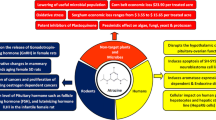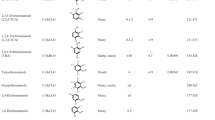Abstract
Citrobacter freundii, the bacterium isolated from marine sediments was capable of degrading 1,2 diamino benzene (DAB), an endocrine disruptor. The mixed intracellular enzymes from C. freundii were extracted and purified. The mixed intracellular enzymes were used for the degradation of DAB and degree of degradation was evaluated in terms of pyruvic acid, the end product, formed. The variables such as effect of pH, temperature and metal ions on the degradation of DAB using mixed intracellular enzymes (MICE) were investigated. The maximum amount of pyruvic acid formed was found to be 569 ± 5 µg with 96 % degradation efficiency at pH 7; temperature 25 °C; zinc nitrate 0.1 mM; and copper sulphate ions 0.15 mM. The stability of MICE at different temperatures and the interaction of MICE with metal ions were confirmed using FT-IR spectroscopy. The formation of pyruvic acid from degradation of DAB followed pseudo-second-order rate kinetics and it was a spontaneous, exothermic process. The activation energy of degradation of DAB by MICE was found to be 82.55 kJ/mol.





Similar content being viewed by others
References
Eberhard Schulz MD, Thomas Munzel MD, FAHA (2011) Intracellular pH—a fundamental modulator of vascular function. Circulation 124:1806–1807
Ang EL, Obbard JP, Zhao H (2009) Directed evolution of aniline dehydrogenase for enhanced bioremediation of aromatic amines. Appl Microbiol Biotechnol 81:1063–1070
Susanne B (2008) Carotenoid oxygenases from Camellia sinensis, Osmanthus fragrans and Prunus persica nucipersica—kinetics and structure. Cuvillier Verlag, Gottingen
IHW (2005) Enzymes, biology mad A-level biology. http://www.biologymad.com/resources/EnzymesRevision.pdf
Silva JJRFD, Williams RJP (1991) The biological chemistry of the elements. Clarendon Press, Oxford
Glusker JP, Katz AK, Bock CW (1999) Metal ions in biological systems. Rigaku J 16(2)
Adalberto PR, Massabni AC, Carmona EC, Goulart AJ, Marques DP, Monti R (2010) Effect of divalent metal ions on the activity and stability of β-galactosidase isolated from Kluyveromyces lactis. J Basic Appl Pharma Sci 31:143–150
Martin chaplin (2014) Effect of pH and ionic strength. http://www1.lsbu.ac.uk/water/enztech/ph.html
Fetzner S (2002) Biodegradation of Xenobiotics. Biotechnology. In: Doelle HW, Da Silva EJ (eds) Encyclopedia of life support systems (EOLSS), developed under the Auspices of the UNESCO. Eolss Publishers, Oxford
de Lorenzo V, Silva Rocha R, Carbajosa G, Galvo TC, Cases I (2010) Spiro S, Dixon R (ed) Sensing xenobiotic compounds: lessons from bacteria that face pollutants in the environment. Caister Academic Press, UK
Cases I, de Lorenzo V (2005) Promoters in the environment: transcriptional regulation in its natural context. Nat Rev Microbiol 3:105–118
de Lorenzo V, Perez-Martin J (1996) Regulatory noise in prokaryotic promoters: how bacteria learn to respond to novel environmental signals. Mol Microbiol 19:1177–1184
Cases I, de Lorenzo V, Ouzounis CA (2003) Transcription regulation and environmental adaptation in bacteria. Trends Microbiol 11:248–253
Saranya P, Muneeswari R, Sekaran G (2014) Biodegradation of endocrine disrupting chemical- o-phenylene diamine using intracellular enzymes from Citrobacter freundii and its kinetic studies. J chem tech biotech. doi:10.1002/jctb.4558
Chung KT, Cerniglia CE (1992) Mutagenicity of azo dyes: structure-activity relationships. Mutat Res 277:201–220
Nezamzadeh-Ejhieh A, Salimi Z (2011) Solar photocatalytic degradation of o-phenylenediamine by heterogeneous CuO/X zeolite catalyst. Desalination 280:281–287
Parilti NB, Akten D (2010) Application of Box-Wilson experimental design method for the solar photocatalytic degradation of textile dyestuff with Fe(III)/H2O2/solar UV process. Desalination 260:193–198
Kothari Charmy R (2006) Microbial degradation of organopollutants, Ph.D. thesis, Department of Biosciences, Saurashtra University
Anthon GE, Barrett DM (2003) Modified method for the determination of pyruvic acid with dinitrophenylhydrazine in the assessment of onion pungency. J Sci Food Agric 83:1210–1213
Lagergren S, Svenska BK (1898) The theory of adsorption on geloester substances. Veternskapsakad Handlingar 24:1–39
Ho YS, Mckay G (1998) Kinetic models for the sorption of dye from aqueous solution by wood. Transl chem E 76B:183–191
Fujieda N, Yabuta S, Ikeda T, Oyama T, Muraki N, Kurisu G, Itoh S (2013) Crystal structures of copper-depleted and copper-bound fungal pro-tyrosinase. J Biol Chem 288:22128–22140
Vallee BL, Auld DS (1990) Active-site zinc ligands and activated H2O of zinc enzymes. Biochemistry 87:220–224
Bertini I, Gary HB, Lippard SJ, Valentine JS (1994) Bioinorganic chemistry. University Science Books, Mill Valley
Lippard SJ, Berg JM (1994) Principles of bioinorganic chemistry. University Science Books, Mill Valley
Wilson CJ, Apiyo D, Wittung-Stafshede P (2004) Role of cofactors in metalloprotein folding. Q Rev Biophy 37:285–314
Golyshina OV, Golyshin PN, Timmis KN, Ferrer M (2006) The pH optimum anomaly of intracellular enzymes of Ferroplasma acidiphilum. Environ Micro 8:416–425
Daniel RM, Peterson ME, Danson MJ, Price NC, Kelly SM, Monk CR, Weinberg CS, Oudshoorn ML, Lee CK (2010) The molecular basis of the effect of temperature on enzyme activity. Biochem J 425:353–360
Yancey PH, Somero GN (1978) Temperature dependence of intracellular pH: its role in the conservation of pyruvate apparent K m values of vertebrate lactate dehydrogenases. J Comp Physiol 125:129–134
Yamasaki S, Sakata-Sogawa K, Hasegawa A, Suzuki T, Kabu K, Sato E, Kurosaki T, Yamashita S, Tokunaga M, Nishida K, Hirano T (2007) Zinc is a novel intracellular second messenger. J Cell Biol 177:637–645
Colemann PL, Weiner H (1973) Growth, isolation, and characterization of a yeast manganese alcohol dehydrogenase. Biochemistry 12:3466–3472
Klinman JP, Welsh K (1976) The zinc content of yeast alcohol dehydrogenase. Biochem Biophys Res Commun 70:878–884
Fusetti F, Schröter KH, Steiner RA, van Noort PI, Pijning T, Rozeboom HJ, Kalk KH, Egmond MR, Dijkstra BW (2002) Crystal structure of the copper-containing quercetin 2,3-dioxygenase from Aspergillus japonicas. Structure 10:259–268
Mukherjee P, Roy P (2013) Copper enhanced monooxygenase activity and FT–IR spectroscopic characterisation of biotransformation products in trichloroethylene degrading bacterium: Stenotrophomonas maltophilia PM102. BioMed Research International (Article ID 723680)
Smith SM, Rawat S, Telser J, Hoffman BM, Stemmler TL, Rosenzweig AC (2011) Crystal structure and characterization of particulate methane monooxygenase from Methylocystis species strain M. Biochemistry 50:10231–10240
O’Halloran TV, Culotta VC (2000) Metallochaperones, an intracellular shuttle service for metal ions. J Biol Chem 275:25057–25060
Beckmann JD, Frerman FE (1983) The effects of pH, ionic strength, and chemical modifications on the reaction of electron transfer flavoprotein with an acyl coenzyme A dehydrogenase. J Biol Chem 258:7563–7569
Pawelczyk T, Easom RA, Olson MS (1992) Effect of ionic strength and pH on the activity of pyruvate dehydrogenase complex from pig kidney cortex. Arch Biochem Biophy 294:44–49
Wu S, Zhang C, Xu D, Guo H (2010) Catalysis of carboxypeptidase A: promoted-water versus nucleophilic pathways. J Phys Chem B 114:9259–9267
Acknowledgments
P. Saranya is grateful to the Council of Scientific and Industrial Research (CSIR), India. The financial assistance under the STRAIT (CSC0201) programme is also gratefully acknowledged.
Author information
Authors and Affiliations
Corresponding author
Electronic supplementary material
Below is the link to the electronic supplementary material.
Rights and permissions
About this article
Cite this article
P, S., G, S. Factors affecting the activation and inhibition of intracellular enzymes for degradation of 1,2 diamino benzene: kinetics and thermodynamic studies. Bioprocess Biosyst Eng 38, 2221–2230 (2015). https://doi.org/10.1007/s00449-015-1460-1
Received:
Accepted:
Published:
Issue Date:
DOI: https://doi.org/10.1007/s00449-015-1460-1




